Lately in my embroidery practice, I've been flipping back and forth between Japanese Embroidery and working on Mrs. Rose.
When last we left Mrs. Rose, I was trying to figure out how I was going to create leaves and leaf stems for the climbing roses. So far, I had found one way, using silk velvet and water-soluble stabilizer that I liked.
Today, I wanted to play with another method of creating an embroidered leaf without the typical wire outline that goes on many versions of stumpwork leaves.
I thought I would try embroidering directly onto the fabri-solvy...trying a fly-stitch leaf and a modification of a fishbone leaf...
When last we left Mrs. Rose, I was trying to figure out how I was going to create leaves and leaf stems for the climbing roses. So far, I had found one way, using silk velvet and water-soluble stabilizer that I liked.
Today, I wanted to play with another method of creating an embroidered leaf without the typical wire outline that goes on many versions of stumpwork leaves.
I thought I would try embroidering directly onto the fabri-solvy...trying a fly-stitch leaf and a modification of a fishbone leaf...
I just quickly couched wire onto the back of the solvy. This was just an experiment so I didn't really care about the finished look of the wire, I just wanted to have it there to hold my leaves in place...
I thought that the two different leaves would behave a bit differently once I dropped them in water.
What I didn't expect was how loopy the stitches came out...regardless of the stitch type I used.
A good lesson learned but this loopy look was not what I was going for so it's back to the drawing board.
Next time I'm adding some green silk organza so that the stitches have something to adhere to...
I'm also going to change my thread to a silk with a tighter twist.
Back to more leafing...









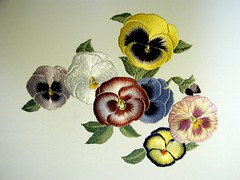
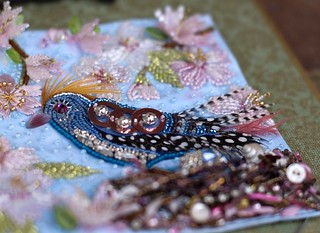
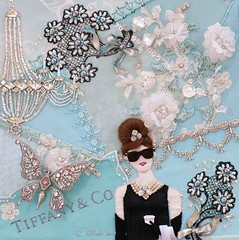
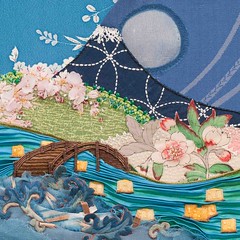
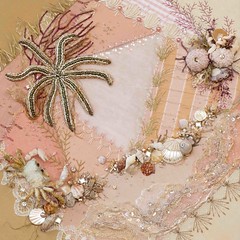


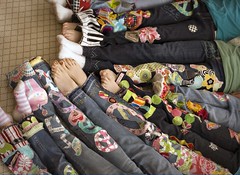









20 comments:
nice experiment. do you have 'things that work' and 'things that don't' folders? i finally put one on my pinterest board, crafts we have tried and whether they worked....or not. now i need an app that keeps track of books i've read/ tv shows i've seen...
They look good from my couch!,
I'm trying to find an alternative way to do the paisleys off block... I think I'll try your suggestion of organza like fabric and solvy.. Will get some tomorrow...
Do save those rejects! ;-)
While these are lovely leaves and will certainly find a place to reside I see they are not the look for Mrs. Rose. You will find your way dear...
If one layer of organza is not enough, try two layers with one at a 45 degree angle to the other. Still light but much sturdier. But I know that you will find a way.
Totally agree with previous comment. I used the 2 layer 45 degree technique on my insect wings. Definitely helped when couching wire and then buttonhole stitching the edge.
Putting so much energy into perfecting a tiny element can be frustrating but so rewarding when everything clicks into place.I look forward to the outcome Susan.
Maybe a split-stitch outline before the fly-stitching?
It is a talented stitcher that shows such close-ups of their work. Thank you for sharing this with us...we all learn!
I think they look good but, what I really think is amazing is that you actually did TWO before you went for the water to see what would happen!! I'd be too anxious, wasteful or not.
It's good to see your experiments--I learn so much! I shall watch to see what process you decide to use.
I've tried singed organza leaves on one project with good success. On a current piece, I'm using stumpwork leaves. Happy stitching.
I had such experiment before too and I didn't like result. Yes, need to embroidery on some fabric.
Here's something I've done quite successfully. Maybe it will help. I embroider on polymesh stabilizer or polyester organza.. It's not a wash away, but I love the results. After the embroidery is finished, I use a heat tool, such as a soldering iron with a wire tip and gently go around the embroidered design, melting the excess stabilizer away. Be sure your tip stays clean, and be careful. The stabilizer melts so a tiny barrier is created so your success don't move around.
Good idea Marlis!
Good idea Marlis!
I wondered how they were going to hold up. I just love your work. I have no desire to do that kind of thing but find it very fascinating and so glad you share
Cool experiment. I like how they turned out. I am looking forward to seeing what you come up with next. :o)
Often in machine embroidery where there won't be any supporting stitches (such as for free standing lace) I will use organza or tulle. Then trim it very close to the stitching. I've even gone so far as to use a stencil cutter and cut the base fabric away leaving just the embroidery. Don't know why this wouldn't work for your leaves. I really enjoy your blog and following your work.
Very interesting, Susan. I'll bet a different thread will help, and it sounds like you've gotten some good suggestions. I admire you patience as well as your beautiful stitching. Mrs. Rose is lucky to have your artistry!
Hello dear,
I'm reading this with the utmost of interest. I will be doing a million (approx) leaves on my Thistle Thread mirror but I find the 'normal' detached leaf approach far too stiff and inorganic as well. I'm no way as far as experimenting with techniques - I'll still be on design drawings/colour for another year, I reckon, given other projects - but this is totally food for thought!!
Post a Comment